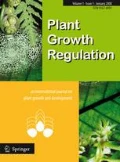Abstract
Correlative dominance requires correlative signals from a dominant to a dominated organ. Auxins, particularly IAA, and cytokinins are obviously important components of this correlative system. Using a vegetative pea shoot and a generative apple and tomato fruit system it can be demonstrated that dominant organs always export more IAA and have a higher 3H-IAA transport capacity and velocity compared to dominated organs. In both systems the dominant organ can be replaced by the application of auxin, e.g. NAA, which maintains the differences in IAA export. This is an indication that similar regulatory mechanisms control dominance in both of these diverse systems. The possibility of replacing a dominant organ by auxin also makes it unlikely that growth of that organ or allocation of nutrients regulates the correlative inhibition of the dominated organ.It is suggested that differences in IAA export from, and transport capacities of, dominant and dominated shoots, may be explained by a mechanism of auxin transport autoinhibition (ATA), whereby the earlier and stronger export of IAA from the dominant shoot inhibits auxin export from the dominated shoot at the point where the two auxin streams converge. This hypothesis was tested with explants of pea, apple and tomato. It was shown that the basal application of cold IAA significantly reduced endogenous as well as exogenous IAA transport through these explants.Since the reduced IAA transport of dominated organs was not followed by an accumulation of IAA in the auxin producing subtending organ, it was concluded that IAA biosynthesis was possibly reduced and/or IAA conjugation stimulated. This could have been one of the determinants of their growth inhibition. ATA might also explain how the unidirectional IAA signal may affect the growth rate of organs even lateral or acropetal to its transport pathway and thus polar IAA-transport becomes a ``multidirectional'' signal. From the experiments demonstrated it seems that ATA is a sufficient mechanism to impose growth inhibition in the dominated organ, without the need of other regulators.However, to release dominated organs from dominance cessation of ATA may not be sufficient and cytokinins are obviously a powerful antagonist to auxins. Their repeated exogenous application turns dominated lateral buds into strongly growing organs which ultimately may even dominate the previously dominant apex. These lateral shoots finally gain a strong IAA export capacity and inhibit, by ATA, IAA export from the hitherto dominant apex.In other experiments it was shown that interruption of polar IAA transport leads to a strong increase in root derived cytokinins. This can largely be prevented, in a concentration dependent manner, by the application of auxin, indicating that basipolar auxin may control cytokinin production in the roots and its possible delivery to lateral buds. In turn, the increased delivery of cytokinins to the lateral buds promotes a strong increase in IAA production and export. Thus there is a strong mutual interaction between auxin production in the shoots and cytokinin production in the roots, which may be important in regulating the balance between root and shoot growth.
Similar content being viewed by others
References
Bangerth F (1989) Dominance among fruits/sinks and the search for a correlative signal. Physiol Plant 76: 608-614
Bangerth F (1994) Response of cytokinin concentration in the xylem exudate of bean (Phaseolus vulgaris L.) plants to decapitation and auxin treatment and relationship to apical dominance. Planta 194: 439-442
Bangerth F (2000) Abscission and thinning of young fruit and their regulation by plant hormones and bioregulators. Plant Growth Reg 31: 43-59
Bohner J and Bangerth F (1988a) Cell number, cell size and hormone levels in semi-isogenic mutants of Lycopersicon pimpinellifolium differing in fruit size. Physiol Plant 72: 316-320
Bohner J and Bangerth F (1988b) Effects of fruit set sequence and defoliation on cell number, cell size and hormone levels of tomato fruit within a truss. Plant Growth Regul 7: 141-155
Cline MG (1994) The role of hormones in apical dominance. New approaches to an old problem in plant development. Physiol Plant 90: 230-237
Faiss M, Zalubilova J, Strnad M and Schmüling T (1997) Conditional transgenic expression of the ipt gene indicates a function for cytokinins in paracrine signalling in whole tobacco plants. Plant J 12: 401-415
Goebel K (1928) Organographie der Pflanzen. Jena: Gustav Fischer Verlag
Goldsmith MHM (1977) The polar transport of auxin. Ann Rev Plant Physiol 28: 439-478
Gruber J (1991) Ñber die Beziehung zwischen dem basipetal polaren Auxintransport und Konkurrenzerscheinungen im Fruchtstand von Apfel und Tomate. Diss. Uni Hohenheim
Gruber J and Bangerth F (1990) Diffusible IAA and dominance phenomena in fruits of apple and tomato. Physiol Plant 79: 354-358
Hertel R and Flory R (1968) Auxin movement in corn coleoptiles. Planta 82: 123-144
Jung J (1972) Die Wasserkultur Höherer Pflanzen. In: Linser M (ed.) Handbuch der Pflanzenernährung und Düngung Vol. 10. Wien: Springer Verlag, p 1136
Kaldeway H (1984) Transport and other modes of movement of hormones (mainly auxins). In: Scott TK (ed.) Encyclopedia of Plant Physiology Vol. 10. Berlin: Springer Verlag, pp 80-148
Klee H and Estelle M (1991) Molecular genetic approaches to plant hormone biology. Annu Rev Plant Physiol Plant Mol Biol 42: 529-551
Lee B Martin P and Bangerth F (1989) The effect of sucrose on the levels of abscisic acid, indoleacetic acid and zeatin/zeatin riboside in wheat ears growing in liquid culture. Physiol Plant 77: 73-80
Li CJ and Bangerth F (1999) Autoinhibition of indoleacetic acid transport in the shoots of two-branched pea (Pisum sativum) plants and its relationship to correlative dominance. Physiol Plant 106: 415-420
Li CJ, Guevara E, Herrera J and Bangerth (1995) Effect of apex excision and replacement by 1-naphthylacetic acid on cytokinin concentration and apical dominance in pea plants. Physiol Plant 94: 465-469
Libbert E (1954) Das Zusammenspiel von Wuchs-und Hemmstoffen bei der korrelativen Knospenhemmung. Planta 45: 68-81
McIntyre GI and Damson E (1988) Apical dominance in Phaseolus vulgaris. The triggering effect of shoot decapitation and leaf excision on growth of the lateral buds. Physiol Plant 74: 607-614
Morris DA (1977) Transport of exogenous auxin in twobranched dwarf pea seedlings (Pisum sativum L.). Some implications for polarity and apical dominance. Planta 136: 91-96
Morris DA and Johnson CF (1990) The role of auxin efflux carriers in the reversible loss of polar auxin transport in the pea (Pisum sativum L.) stem. Planta 181: 117-124
Phillips IDJ (1975) Apical dominance. Ann Rev. Plant Physiol 26: 341-367
Riov J, Dror N and Goren R (1982) Effect of ethylene on 14C-indole-3-acetic acid metabolism in leaf tissues of woody plants. Plant Physiol 70<nt>vn</nt>: 1265-1270
Sachs T and Thimann KV (1967) The role of auxins and cytokinins in the release of buds from dominance. Am J Bot 54: 136-144
Sanyal D and Bangerth F (1998) Stress induced by mechanical bending of apple shoots and its effect on ethylene evolution, auxin transport, cytokinin levels and relation to flowering. Plant Growth Reg 24: 127-134
Shen-Miller J (1973) Rhythmicity in the basipetal transport of indolacetic acid through coleoptiles. Plant Physiol 51: 615-619
Shimizu S and Mori H (1998) Analysis of cycles of dormancy and growth in pea axillary buds based on mRNA accumulation patterns of cell cycle-related genes. Plant Cell Physiol 39: 255-262
Snow R (1925) The correlative inhibition of the growth of axillary buds. Ann Bot 39: 841-859
Snow R (1937) On the nature of correlative inhibition. New Phytol 36: 283-300
Stafstrom JP (1993) Axillary bud development in pea: apical dominance, growth cycles, hormonal regulation and plant architecture. In: Amansino RM (ed.) Cellular Communication in Plants. New York Plenum Press, pp 75-86
Suttle JC (1988) Effect of ethylene treatment on polar IAA transport, net IAA uptake and specific binding of N-1 naphtylphthalamic acid in tissues and microsomes isolated from etiolated pea epicotyls. Plant Physiol 88: 795-799
Tamas IA (1987) Hormonal regulation of apical dominance. In: Davies PJ (ed.) Plant Hormones and their Role in Plant Growth and Development. Dordrecht: Martinus Nijhoff, pp 393-400
Tamas IA, Schlossberg-Jacobs JL, Lim R, Friedman LB and Barone CC (1989) Effect of plant growth substances on the growth of axillary buds in cultured stem segments of Phaseolus vulgaris L. Plant Growth Reg: 165-183
Thomas TH (1983) Effect of decapitation, defoliation and stem girdling on axillary bud development in Brussels sprouts. Sci Hort 20: 45-51
Wickson M and Thimann KV (1958) The antagonism of auxin and kinetin in apical dominance. Physiol Plant 11: 62-74
Woolley DJ and Wareing PF (1972) The interaction between growth promoters in apical dominance. New Phytol 71: 781-793
Zajaczkowski S, Wodzicki TJ and Romberger JA (1984) Auxin waves and plant morphogenesis. In: Scott TK (ed.) Encyclopedia of Plant Physiol Vol. 10. Heidelberg: Springer Verlag, pp 244-262
Author information
Authors and Affiliations
Rights and permissions
About this article
Cite this article
Bangerth, F., Li, CJ. & Gruber, J. Mutual interaction of auxin and cytokinins in regulating correlative dominance. Plant Growth Regulation 32, 205–217 (2000). https://doi.org/10.1023/A:1010742721004
Issue Date:
DOI: https://doi.org/10.1023/A:1010742721004




